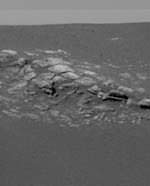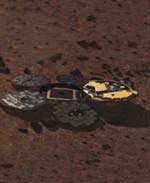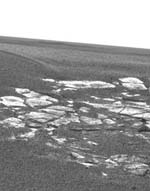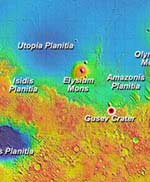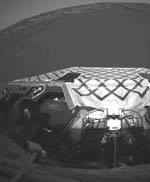
Image credit: NASA/JPL
NASA’s Opportunity rover has untucked its front wheels and latched its suspension system in place, key steps in preparing to drive off its lander and onto martian soil.
Overnight tonight, mission controllers at NASA’s Jet Propulsion Laboratory, Pasadena, Calif., plan to try tilting the lander platform down in the front by pressing the rear petal downward to raise the back.
“What we want to do is lower the front edge by about 5 degrees,” said JPL’s Dr. Rick Welch, activity lead for preparing the rover for roll-off. Plans call for driving off straight ahead, possibly as early as overnight Sunday-Monday, if all goes well.
Meanwhile, halfway around Mars, Opportunity’s twin, Spirit, continues on the mend from a computer memory problem that struck it a week ago. “Right now we’re working to get complete control of the vehicle, and we’re still not quite there,” said JPL’s Jennifer Trosper, mission manager. “If we’re on the right track, we hope to be back doing some science by early next week. If we’re not on the right track, it could take longer than that.”
Opportunity’s infrared sensing instrument, the miniature thermal emission spectrometer, passed a health check last night. Scientists plan to begin using it tonight. The instrument detects the composition of rocks and soils from a distance. That information will help scientists decide what targets to approach after Opportunity drives off the lander.
Scientists and rover engineers are already discussing which specific rocks within an outcropping near the lander will make the best targets, said Dr. Jim Bell of Cornell University, Ithaca, N.Y., lead scientist for the panoramic cameras on Opportunity and Spirit. Details of the outcrop can be seen in a new a color-picture mosaic Bell presented, the first portion of a full-circle panorama that has been taken and partially transmitted.
Other new images show how Opportunity’s airbags left detailed impressions in the fine-textured soil as the spacecraft was rolling to a stop in the small crater where it now sits. “These marks are telling us about the physical properties of the material,” Bell said.
Some scientists believe that dark colored granules covering most of the crater’s surface were pressed down into an underlying layer of powdery, lighter red material when the airbags hit. Others hold to a theory that the dark granules are agglomerations that crumble into the finer, lighter material when disturbed. After roll-off, soil near the lander will be the rover’s first target for close-up examination with a microscope and two tools for detecting the composition of the target. The soil at Opportunity’s landing site appears to have different properties than the soil at Spirit’s landing site, Bell said.
Opportunity has already validated predictions about the landing site made on the basis of images and measurements taken by spacecraft orbiting Mars, said JPL’s Dr. Matt Golombek, a member of the rover science team and co-chair of a steering committee that evaluated potential landing sites for the rovers. The predictions included that the region of Meridiani Planum where Opportunity landed would be safe for landing, would be safe for rover driving, would have very few rocks and would look unlike any place previously seen on Mars.
“This bodes well for our ability to use remote sensing data in the future for picking landing sites,” Golombek said.
Engineers have been able to confirm a diagnosis that an unplanned drawdown of battery power each night on Opportunity is due to a heater on the rover’s robotic arm. A switch designed to overrule the heater’s thermostatic control has not been working. “In the near term, it’s not providing any operational constraints,” Welch said.
JPL, a division of the California Institute of Technology in Pasadena, manages the Mars Exploration Rover project for NASA’s Office of Space Science, Washington, D.C. Images and additional information about the project are available from JPL at http://marsrovers.jpl.nasa.gov and from Cornell University at http://athena.cornell.edu.
Original Source: NASA/JPL News Release



